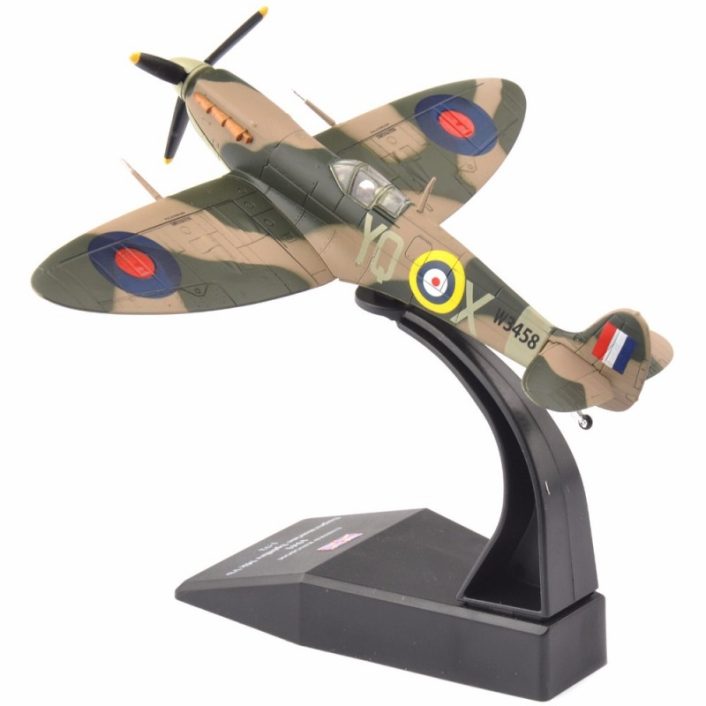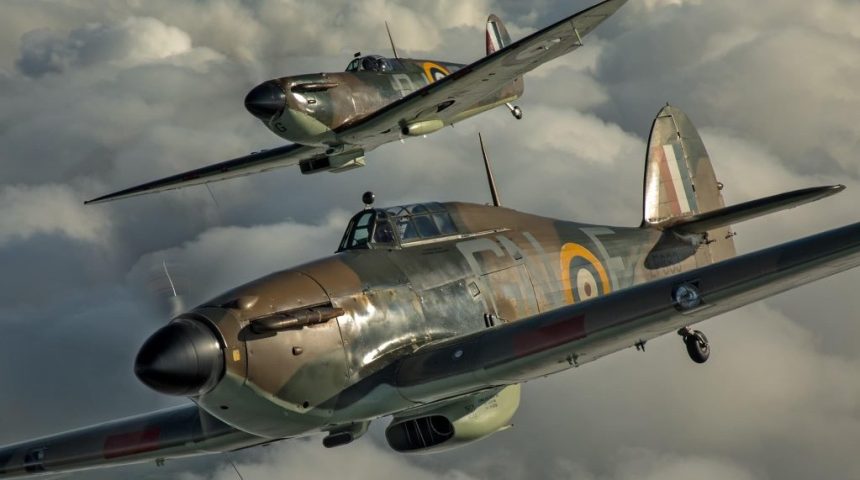The Battle of Britain was the first major defeat of Germany during World War 2.
October 31, 2020 conventionally marks the 80th anniversary of the end of the Battle of Britain. The battle, described also as the first major campaign to be fought entirely by air forces, begun on July 10, 1940 and ended on October 31 of the same year. Actually, the real combat lasted longer that the roughly three months officially recognized, as the fighting started months before, just after the Fall of France, and ended months later in 1941.
The air campaign was initiated by the German Luftwaffe in an effort to completely destroy the Royal Air Force before launching Operation Sealion (Unternehmen Seelöwe), the seaborne invasion of the United Kingdom. The country endured massive aerial bombings raids, with the outnumbered Royal Air Force strenuously opposing the Luftwaffe’s bombers and fighters, ultimately succeeding in negating the opponent’s air superiority and forcing Germany to renounce to Operation Sealion, considered the first major defeat of Hitler during World War 2.
The Battle of Britain, however, was not the first armed confrontation between the two countries. Let’s see how the events escalated until the first dogfights between German and British fighters.
Everything begun in 1936 when Hitler intervened in the Spanish Civil War, showing that the Luftwaffe was ready for war and not dismantled as it was decided with the Treaty of Versailles after WW1. Germany employed for the first time the powerful Messerschmitt Bf 109 monoplane fighter and the Heinkel He 111 bomber. The RAF at that time was still flying biplanes like the Gloster Gauntlet.
The @RAFBBMF flew over London today for the Battle of Britain 80 service at @wabbey.
In 1940 people across the UK & around the world came together to defend our skies. The RAF is proud to remember those who made this victory possible.https://t.co/wKSmQZYrzx#DetectAndDefend pic.twitter.com/064O9spb8k
— Royal Air Force (@RoyalAirForce) September 20, 2020
When Hitler’s intentions to expand Germany became clear, an invasion of Czechoslovakia was averted (at least for the time being) with the Munich Agreement in 1938, called also Chamberlain’s appeasement, from the then British Prime Minister that was trying to avoid the imminent war. Heavy critics followed the agreement, however the UK obtained this way a much needed year of breathing space.
During that year the RAF continued to ream with its first monoplane fighters, the Hawker Hurricane, first delivered at the end of 1937 to No. 111 Squadron based at Northolt, and the Supermarine Spitfire, first delivered in the summer of 1938 to No. 19 Squadron based at Duxford. The Hurricanes became indeed the workhorse of the RAF, ultimately equipping 27 squadrons, while the Spitfires equipped only 19 squadrons. Even if the Hurricane’s performance were slightly lower than the Spitfire’s, its ruggedness proved to be of great value with the aircraft being able to sustain a lot of damage in fight and still return to base.
The squadrons immediately started to develop new tactics that were then tested in battle against the Luftwaffe over France and Norway with the Hurricane in late 1939 and early 1940, while the more complex Spitfires flew for the first time in combat in France.
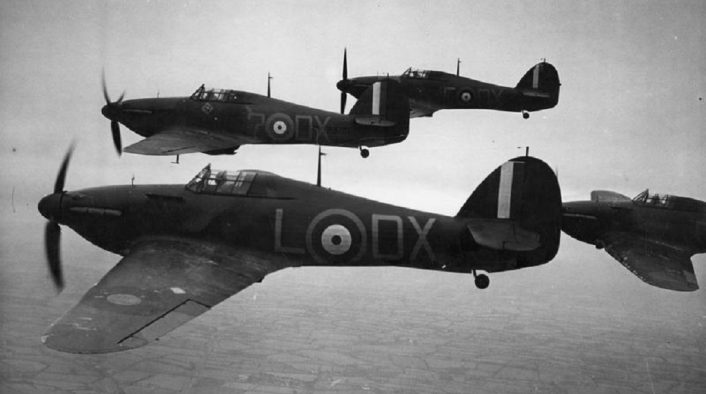
The first major operation for the new fighters was Operation Dynamo, the Dunkirk evacuation, which exposed some technical deficiencies in the Spitfire and poor combat tactics. 19 Squadron was the first to test the cannon-equipped Spitfire Mk 1B, in response to the cannon-equipped Bf 109, but the new weapon suffered frequent stoppages and low ammo capacity. The Mk 1B featured the de Havilland Constant Speed propeller which offered a first increase in the performance, later replaced by the improved CS airscrew. The Hurricane also received a CS propeller reducing the performance gap with the Bf 109.
After the fall of France, the RAF began to prepare to defend the homeland during the first phase of the Battle of Britain. A first phase preceded the battle and saw the Germans performing “nuisance raids” against coastal targets and mine laying operations. The first real phase saw the Luftwaffe mainly attacking coastal targets and shipping convoys in the Channel. During this phase the so-called Dowding system, the first wide-area ground-controlled interception network devised by Air Chief Marshal Hugh Dowding, begun to show its effectiveness.
80 years ago the Battle of Britain formally ended
Over 113 days the RAF had tirelessly defended UK skies. 544 RAF aircrew lost their lives, as well as 312 ground crew
The RAF continues to protect UK airspace, 24/7, 365 days a yearhttps://t.co/wKSmQZGQaX#DetectAndDefend pic.twitter.com/Rb0fUiizDp
— Royal Air Force (@RoyalAirForce) October 31, 2020
The system gathered information about Luftwaffe activity using radar and ground observers, while telephones were used to distribute the collected info to the various Fighter Commands and Sector Controls to initiate scrambles and give orders to fighter squadrons. In the final organization, four Fighter Commands were operative: 10, covering the south-west of England and south Wales; 11, covering London and the south; 12, covering the industrial Midlands; 13, covering the north and Northern Ireland. The Dowding system is considered one of the most important key factors that contributed to the success of the RAF.
The second phase begun at the end of the first week of August, with the Luftwaffe targeting everything related to the RAF: airfields, radar installations, aircraft, aircraft manufacturers, suppliers. At the same time, the RAF started receiving new Spitfires armed with both two 20 mm cannons and four .303 Browning machine guns.
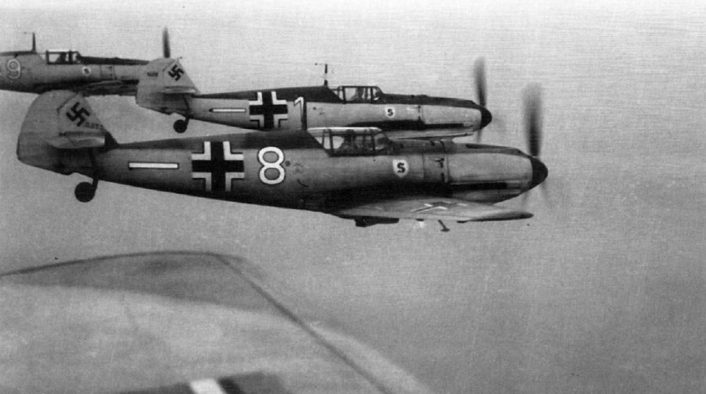
August 13 was Adler Tag, the “Eagle Day”, and marked the beginning of the main assault or Adlerangriff, “Attack of the Eagles”. On this day, heavy bombing raids made by formations of up to 300 aircraft between Bf 109 and Bf 110 fighters and He 111, Dornier Do 17, Junkers Ju 88 and Ju 87 “Stuka” bombers. The raids had not the effect expected by Germany due to faulty intelligence that led to poor target selection and the unexpected resistance of the RAF. The defensive system however showed some limitations, as the few times the fighters from 12 Group were scrambled it was already too late to join the fight because bombers already left the area, as they had to wait for 11 Group to ask for assistance.
August 15 has been described as “The Greatest Day”, one of the historic dates of the battle, with the largest number of German sorties of the entire Battle and the first attacks in the 13 Group’s area. Trying to reduce the losses, the Luftwaffe started heavy night raids of 500/600 aircraft, in a proportion of three fighters for each bomber, hoping that the RAF would have a hard time intercepting them in the dark.
Here is how then Flight Lieutenant Brian Lane of 19 Squadron wrote about one of those raids in his report:
We took off and circled the aerodrome, climbing for height, then Woody’s voice came through: ‘Climb to 15,000 feet. There might be some “trade” for you on your way back’. We set course and climber up through the sunlit haze and broken cloud.
We flew for some minutes until I judged we must be near the coast. Then, from behind a bank of cloud sailed five Heinkels – then another five, and another, and another! A steady stream if aircraft appeared from the cloud… There must have been at least 150 of them. Heinkels and Me 110s fighters, and way above showed twelve thin white pencil of smoke – the top escort.
Brian Lane was one of the first Spitfire pilots of 19 Squadron. An appreciated leader, his history and squadron’s contribution to the Battle of Britain is recounted in the book Spitfire! The Full Story of a Unique Battle of Britain Fighter Squadron. The book is the result of extensive research with first-hand accounts and official reports from the people who took part in the Battle, with plenty of details about the preparation for the war, the evolution of the tactics, the dogfights, the problems of the first Spitfires and how they were solved. Definitely a must read for any WW2 aviation fan.
18th August known as the “Hardest Day” during the Battle of Britain. 850 German sorties with 2200 aircrew vs 970 RAF sorties with 600 aircrew. Sandy Lane’s face says it all. #bob80 #lestweforget @Disco_BBMF @BBMF_Sugden @Seb_Lanc99 @BBMF_Ernie93 @ColBostrom @Farrell3Neil pic.twitter.com/ZvIxmqsTIH
— RAF BBMF (@RAFBBMF) August 18, 2020
Then came “The Hardest Day” on August 18, with the Luftwaffe launching again an all out attack against the RAF, with raids (both high-altitude and low level) concentrated mainly on Biggin Hill and Kenley airfields, the largest operated by fighters. Unknown to German intelligence, the two airfields hosted also sector control operation rooms. Both sides suffered the most losses than any other day of the campaign.
Another phase begun on September 7, with the self-explanatory name of Operation London (Unternehmen Loge). The main focus of Reichsmarschall Göring was a round-the-clock bombing of London to exhaust the fighter command. One of the changes made by 12 Group to counter the Luftwaffe was the so-called Big Wing or Duxford Wing envisioned by the then Squadron Leader Douglas Bader (flying Hurricanes with 242 Squadron) which featured scrambles of multiple squadrons, initially three and then increased to five squadrons, instead of single squadrons.
Bader was a charismatic pilot that and, even if sometimes he got grumpy with other pilots, he was well respected and determined to succeed. This was clear early in his career, when he lost his legs in a flight accident. After being medical discharged, he kept insisting to return to fly using prosthetic legs until he was finally accepted soon after the outbreak of WW2. Bader had soon his first experiences with the Spitfire in 19 and 222 Squadrons, getting his first aerial victories over France and starting to develop his tactics, even if they were not shared by the RAF, before being appointed as the commander of 242 Squadron with the Hurricanes.
Another tactic preferred by Bader was to get the interceptors higher than the attackers and up-sun, achieving a higher energy state before the attack ad making difficult for the Germans to get their eyes on the RAF aircraft. The Hurricanes then proceeded to perform diving attack on the bombers while the Spitfires engaged the fighter escort. The Big Wing was surrounded by controversy but was also highly effective, as proved later in the campaign.
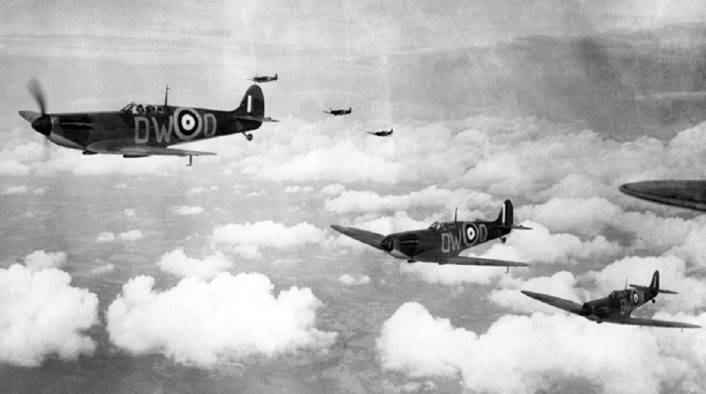
The heaviest raids of this phase were on September 15, with hundreds of bombers again intentioned to bomb London by day and night. Here the Duxford Wing proved the efficiency of this formation shooting down more than 50 aircraft in a day against about 30 aircraft lost. That day proved also to be decisive for the future of Operation Sealion, with the Luftwaffe exhausted and unable to obtain the aerial supremacy needed for the invasion that was subsequently indefinitely postponed. 15 September has been called since then the Battle of Britain Day.
With the last phase the Germans tried a new strategy, with night bombing raids and daylight fighter-bomber raids during the day. The Bf 109 became fighter-bombers with the addition of a single bomb per aircraft, and they were usually escorted by 200 to 300 fighters. The RAF had to change defensive tactics by introducing standing patrols of Spitfires at high altitude to monitor incoming raids.
The Battle of Britain officially ended on October 31, although bombing raids over the UK continued until 1941 in the campaign known as the Blitz. At the end of the Battle, the RAF lost about 1700 aircraft and 1500 aircrews, while the Luftwaffe lost about 2000 aircraft and 2500 aircrews, out of the initial 2000 and 2500 aircraft respectively. During the war the losses were largely overclaimed, often between a 3:1 and 5:1 factor, due to the so-called “fog of war”: records often were incomplete due to information lost during the attack, aircraft crashed but difficult to verify, multiple fighters attacking the same target and claiming the same victory.
On this day in 1940, Winston Churchill paid tribute to ‘The Few’
He also praised bomber crews, who were striking enemy targets on a daily basis
This year we are commemorating the sacrifices made by the greatest generation during WW2https://t.co/wKSmQZYrzx#DetectAndDefend pic.twitter.com/0jXru1kgKt
— Royal Air Force (@RoyalAirForce) August 20, 2020
During the war, we could say that the two sides hated each other, but there was also mutual respect. For an instance in 1940, then Flight Lieutenant Peter Townsend, assigned to 43 Squadron, was among the first Hurricane pilots to encounter the Luftwaffe. In an occasion, he and his fellow pilots tried to help the crew of a doomed He 111 to reach safety overland instead of ditching their aircraft in the sea:
As I came in I could see the tail unit was already wobbling and the engines streaming vapour. I turned aside and as the Heinkel glided down I flew in very close alongside it. [Flight Lieutenant] Caesar Hull stationed himself on the other side. The rear cockpit bore the signs of a charnel house with the gunner slumped inside it mutilated beyond recognition. His fair hair streaming in the slipstream which rushed through his shattered windscreen, the young pilot bent over the controls trying to urge his stricken machine to fly. Through the window panels the two other members of the crew regarded me in silent despair. I pushed back my hood and signalled them to turn towards the coast. Those men were no longer enemies but airmen in distress. If only we could have borne up their doomed aircraft with our own wings. I knew I was watching the last moments of three brave men as they went down to perish in the sea. I watched the Heinkel until, unable to fly any more, it alighted awkwardly on the sea. The fuselage broke in half. One wing tipped crazily in the air then slithered under the surface. As I circled low overhead I could see the three men in yellow life-saving jackets struggling free and beginning to swim. Like some of the others I called base to fix our position and ask for help. We were some twenty miles from the coast. The three Germans would be dead long before help could reach them.
This episode is recounted in the book They flew Hurricanes, dedicated to the story of this often forgotten fighter that was crucial to the final victory in the Battle of Britain, especially in the early days when few Spitfires were available and they were kept in reserve to defend London. The book covers with abundance of details the design of the Hurricane, the impact it made in the RAF as the first monoplane aircraft with the new retractable undercarriage and the operational history in the various combat theaters, including its naval employment.
During the Battle of Britain, the RAF faced a shortage of pilots, rather than aircraft. A first solution was to let non-commissioned officers and airmen from other fields to train and fly in the first lines. Another relief was provided by foreign volunteers from all over the Commonwealth and occupied Europe, ultimately leading to the creation of multiple Polish, Czech and Canadian squadrons, in addition to pilots from other countries attached to British squadrons, mainly from Australia and New Zealand. In total, almost 600 foreign pilots took part in the Battle of Britain.
The Battle of Britain ended 80 years ago today
It was an international victory. Nearly 3000 Allied aircrew took part. A fifth weren’t British
We are proud to commemorate the sacrifice made by all those who defended our skies in 1940https://t.co/wKSmQZGQaX#DetectAndDefend pic.twitter.com/4TiCNkV1DU
— Royal Air Force (@RoyalAirForce) October 31, 2020
The “Few”, as the RAF pilots were called, were supported by nearly one and a half million people, including ground crews, Observer Corps, anti-aircraft gunners and searchlight operators, the Women’s Auxiliary Air Force serving in various roles such as radar operators and plotters in the sector controls, and finally the Local Defence Volunteers and aircraft factory workers. Another often forgotten support came from the Bomber Command, who attacked German industries and the ports where the invasion force was being assembled, and the Coastal Command, who provided standing patrols and reconnaissance on German forces on the European coast.
While the Luftwaffe misjudged the RAF, believing that it could be easily beaten and quickly destroyed because it was largely outnumbered, the British pilots never considered being beaten, heroically fighting day and night with little rest, often sacrificing their life for the cause. One of these episodes involves then Flight Lieutenant James B. Nicolson of 249 Squadron, the only pilot who won the Victoria Cross during the Battle of Britain.
Wild white trails streaked the sky over Southampton and the Isle of Wight. Nicolson was told to intercept enemy fighters. With other Hurricanes of his squadron, he made contact. Scrapping at 300 mph, the aeroplanes wove their weird exhaust fleece four miles over Southampton Water.
Nicolson took on one Messerschmitt but as he was still trying to get into position to attack, the German fired at the Hurricane. Four cannon shells screeched into it. One pierced the cockpit, injuring one of Nicolson’s eyes; another hurt his foot badly; the remaining two damaged the Hurricane’s engine and set fire to the gravity tank.
Petrol poured out of the tank, over the cylinders, and seeped into the cockpit below the control-panel. Flames started to spread and scorch the whole cockpit. The airscrew fanned them, until Nicolson could scarcely see the Messerschmitt’s movements – hurt as he was in one eye. Now burns began to affect him, too, and he could only control the fighter with the greatest strain.
By now the lower part of the control-panel and the floor of the cockpit were burning, and the entire machine would soon be an inferno. Nicolson reached for the hood-release and struggled out of the searing cockpit, his limbs already badly scorched. But just as he forced himself up to jump, he saw a Messerschmitt in front of him.
Without stopping a second, he slid back into the flaming cockpit, took hold of the stick again, and his feet groped for the rudder bar. He hardly knew what he was doing or how he was doing it. The whole of the lower part of the Hurricane flared into flames. Somehow Nicolson kept the stuttering engine going, and sighted himself on the enemy fighter. His wounded eye was worse each moment. Up to his waist in flames, his hands blistering on the controls, he battled on until his range was close enough to be entirely accurate. Nicolson pressed the firing button.
A stream of bullets bore straight down at the enemy. The Messerschmitt reeled away mortally hit and careered to the ground; but Nicolson was still in a blazing furnace of a fighter. Summoning strength and will from somewhere deep within him, he struggled to raise himself a second time out of that candle of a cockpit. He operated the hood-release – and baled out. He pulled his ripcord, and then passed out, landing unconscious just outside Southampton – with bad burns on his hands, face, neck and legs. But as he was still drifting down – just before hitting the ground – one of the Local Defence Volunteers fired on Nicolson and hit him in his buttocks. He had been mistaken for an enemy pilot. This in addition to everything else endured.
BoB 75 saw the @RAFTyphoonTeam painted in Flt Lt Nicolson’s Hurricane codes. Nicolson was the only Fighter Command pilot to receive the VC during WW2. Photo by John Dibbs @Disco_BBMF @BBMF_Sugden @Farrell3Neil @BBMF_Ernie93 @Seb_Lanc99 pic.twitter.com/OMVK77ZApg
— RAF BBMF (@RAFBBMF) August 26, 2020
The recount of Nicolson battle is an extract from another book, The Battle of Britain, which provides a thorough account of the air campaign since the delivery of the first new fighters and covering also the Blitz after the end of the Battle of Britain in late 1940 and 1941. The book does a great work at dissecting the campaign in a day-to-day narrative, detailing the contribution of all pilots and squadrons from Fighter, Bomber and Coastal Commands, with a focus on 12 Group with its Big Wing and in the involvement in the defense of London, while also not forgetting the contribution of the ground crews and the WAAF.
